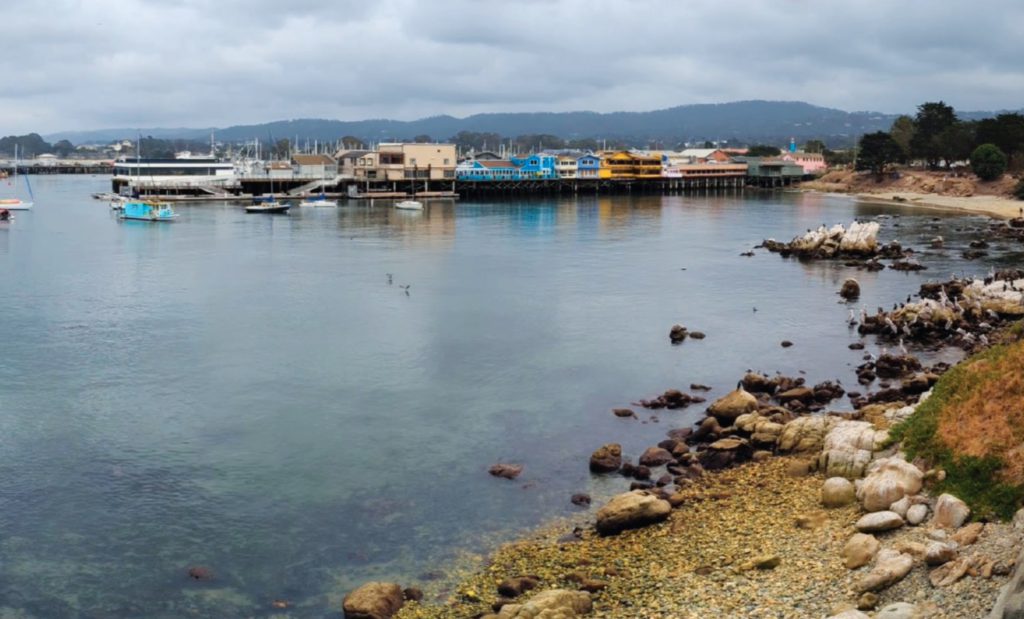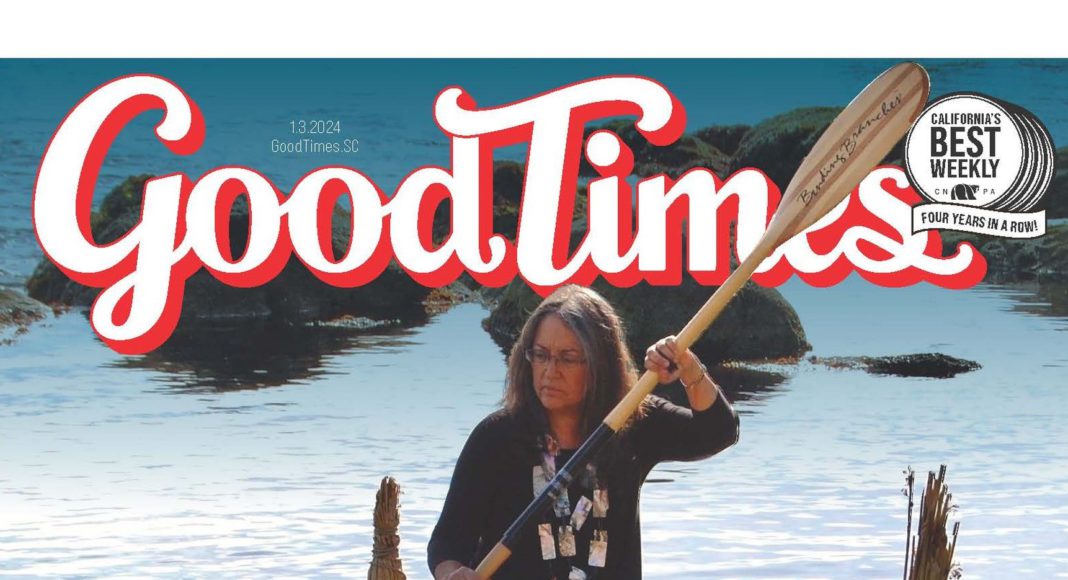The original inhabitants of Monterey Bay were many things: artists and engineers, hunters and foragers, healers and collaborators, spiritual seekers and problem solvers, herbalists and songmakers and storytellers.
As much as anything, the area’s indigenous were fishermen and women.
Local fisheries historian and author Tim Thomas, after decades studying the interplay of the earliest inhabitants and Monterey Bay, understands this well.
“I always remind people: Native people were the first commercial fishermen in Monterey,” he says. “It’s how they made their living.”
In other words, fishing was more than sustenance. It was a means of forging alliances with other regional tribes—sprinkled with dancing and story swapping—and trading for things like pelts, fish hooks and obsidian for spear and arrow points.
As Robert Cartier writes in “An Overview of Ohlone Culture” for the Santa Cruz Public Libraries’ Local History Collection, Monterey Bay’s original fisherfolk were wildly diversified in their seafood diet.
“The more important fish included steelhead trout, salmon, sturgeon, and lampreys,” he writes. “Shellfish were [also] extremely important to the Ohlone…mussels, abalone, clams, oysters, and hornshell.
“You name it,” Thomas says, “they were fishing for it.”

Through the Generations
Linda Yamane is a native Rumsen Ohlone who lives on the same lands as her ancestors (“Seaside, California” in present-day parlance). She has dedicated her life to learning, recreating and sharing Rumsen Ohlone language and fundamental customs, while teaching herself how to craft hand-woven vessels like stunning coiled baskets and tule boats. (Check out “Ohlone Basket Weaver” on YouTube for additional texture and technique.)
As a small part of her calling as a “culture bearer,” Yamane recently composed the Native American component of a new Bounty of the Sea: A History of Fishing in the Monterey Bay exhibit at Stanton Center in Monterey.
The tall banner, titled “Bounty of the Bay: Monterey’s First Fishermen,” describes the tools and strategies the Rumsen applied: Harpoons intercepted steelhead and salmon navigating up streams during spawning season; dip nets made from fibrous plants and knotted with hand-made string scooped sardines, anchovies and smelt from boats and shore alike; bigger nets stretched from a stationary Rumsen on the coast to a boat, encircling schools of near-shore fish, in what likely was the first seine fishing the West Coast has seen.
“Rumsen communities thrived in a world that was unimaginably rich in wildlife and other natural resources,” the banner reads, in part. “Living close to nature and relying directly upon it for all of life’s needs, Rumsen people used their knowledge, experience and human ingenuity to successfully harvest the bounty of Monterey Bay.”
The museum where it hangs abuts the Custom House Plaza and the National Historic Landmark house itself, on the cusp of Fisherman’s Wharf.
In some ways, Custom House sits at the heart of Old Monterey history. As the various artifacts on display inside help illustrate, it was constructed in 1827 by Mexico’s national administration and represents the oldest surviving government building in California. It was also where the first American flag was officially raised statewide, and where a replica wooden flagpole now stands .
But compared to the indigenous backstory, that colonial history has a new car smell.
Thousands of years before the Spanish, Mexican or American colonization eras descended, Monterey was known as Achista, and the same spot where the Custom House sits was a Rumsen fishing camp.
Tribal Times
An unscientific poll of fishermen casting off Wharf II in Monterey hints at a vacuum of understanding.
Asked who were the first fishermen on Monterey Bay, the answers range from “I don’t know” to “the paisanos.” Correct answers represent a minority of responses.
One fisherman lands it immediately, however: “The Ohlone,” he says, adding that after a good rain he likes to traverse the midden soils above the Recreation Trail that rims the harbor, beneath the Defense Language Institute, looking for native artifacts.
He holds out his right hand, his thumb and forefinger a good 3 inches apart. “I once found a spearhead this long,” he says. (It bears mentioning that such foraging is illegal.)
Valentin Lopez, longtime chairman of the Amah Mutsun Tribal Band, knows much is lost without some foundational history, including a simple but powerful perspective.
“We have to respect and love [native seafood species],” he says. “We look at fish as a relative, with the same Father Creator and the same Mother Earth. We have a responsibility to them. We have to pray for them, sing for them, create relationships and listen…and not view them as a commodity, not solely as a resource that needs to be dominated or domesticated.”
Yamane has collided with the absence of awareness repeatedly. She recounts an example on the Rumsen Ohlone “Happenings” blog.
While she was demonstrating Ohlone basket weaving at State Parks’ annual Christmas in the Adobes, she heard an event goer wonder, “Are these people extinct?”
“I was able to assure him that we are not extinct — that we are still here, there are many of us, and that I had made the baskets and abalone necklaces and beautiful ear ornaments, the clapper sticks and deer hoof rattle on the tables in front of him,” she writes. “Our language and culture are not dead.”
Fortunately a number of avenues exist to help fill the vacuum.
Chairman Lopez’s Amah Mutsun host a range of ongoing activities designed for public participation. Interested parties can volunteer for monthly work days at Pie Ranch and San Juan Bautista State Historic Park.
In addition, the Amah Mutsun Land Trust has partnered with Sempervirens Fund, California Nativescapes, and members of the Muwekma Ohlone Tribe to design and install an ethnobotanical demonstration plot. The Mutsun Garden at the Robert C. Kirkwood entrance to Castle Rock State Park, thriving with 60 native species, welcomes visits from sunrise to sunset.
Central Coast citizens can also track and support the effort to protect sacred Juristac grounds from development as a gravel quarry (see sidebar, p. 20). In fall 2022, Santa Cruz County’s Board of Supervisors unanimously approved a resolution in support of the Amah Mutsun Tribal Band’s efforts to protect Juristac, urging the County of Santa Clara to deny permits for the proposed project.
Supervisor Manu Koenig introduced the motion for the board to write a letter to the Santa Clara County Supervisors asking that they reject mining at Juristac after public comment letters arrived by the hundreds. The memo acknowledges impacts to wildlife beyond the property’s borders, pointing out “although the Sargent Ranch Quarry Project is located in Santa Clara County, the nature of the mining project encompasses issues that would negatively impact the County of Santa Cruz.”
Back in Old Monterey, the fishing salon at Stanton Center awaits viewers 11am-5pm Saturday-Thursday, and remains on display through August 2025.
Down the Rec Trail and along the midden soils that ring the bay sits Monterey Bay Aquarium, where one of Yamane’s woven kónon boats is kept for educational appearances next to the Great Tide Pool.
On top of that, the multidimensional exhibit Contemporary Indigenous Voices of California’s South Coast Range opens at the de Young museum in San Francisco’s Golden Gate Park. It launched with three hours of free programming this fall that included Yamane leading a basketry demonstration. She also participated on a panel as part of a deep and curated sequence of conversations with artists, cultural leaders, and elders from several Bay Area tribal groups.
The wider de Young exhibition features portraits of indigenous community members from the the San Francisco peninsula through the Santa Cruz mountains, Monterey Bay and lower Salinan Valley, by fine art photographer Kirti Bassendine. They come accompanied by powerful personal statements from native community members illuminating cultural connections to the land, rematriation and climate change.
The exhibit will be in place through Jan. 7.
We are Still Here
As Cartier observes in “An Overview of Ohlone Culture,” the story of the region’s first fishermen is incomplete.
“The ethnographic story of the Ohlone is occasionally rich with knowledge about a life that was so incredibly different from the civilization that now stands in its stead,” he writes, “while on the other hand it is an incomplete story, or only a rough outline, with gaps as yet undiscovered and untold.”
As the Rumsen Ohlone make vibrantly clear, the story is ongoing, filling those gaps.
“We are still here,” Yamane writes on the “Happenings” blog, “keeping our culture, our community spirit, and the memory of our ancestors alive.” ⬛
A version of this story first appeared at Monterey Bay Fisheries Trust’s website, a nonprofit group dedicated to helping the Central Coast’s marine ecosystem thrive for all species, and where Mark C. Anderson is a contributing writer.














Where can I buy Linda’s jewelry?